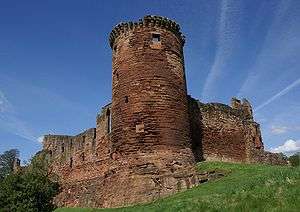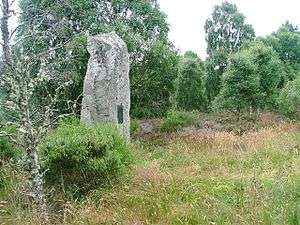Andrew Murray (Scottish soldier)
Sir Andrew Murray (1298–1338), also known as Sir Andrew Moray, or Sir Andrew de Moray, was a Scottish military and political leader who supported David II of Scotland against Edward Balliol and King Edward III of England during the so-called Second War of Scottish Independence. He held the lordships of Avoch and Petty in north Scotland, and Bothwell in west-central Scotland. In 1326 he married Christina Bruce, a sister of King Robert I of Scotland. Murray was twice chosen as Guardian of Scotland, first in 1332, and again from 1335 on his return to Scotland after his release from captivity in England. He held the guardianship until his death in 1338.
Sir Andrew Murray | |
|---|---|
| Born | Pentecost 1298 |
| Died | Lent 1338 (aged c. 40) |
| Resting place | Dunfermline Abbey |
| Nationality | Scottish |
| Known for | leading resistance campaign during Second War of Scottish Independence |
| Title | Guardian of Scotland, Lord of Petty and Bothwell |
| Spouse(s) | (1) Unknown; (2) Christina Bruce |
| Children | John Murray; Thomas Murray. |
| Parent(s) | Father: Andrew Moray |
| Relatives | Brother-in-law: Robert I of Scotland. |
Early years
Andrew Murray was born in 1298, around Pentecost.[1] He was the son of Andrew Moray, William Wallace's companion-in-arms, who died following the Battle of Stirling Bridge, shortly before his birth. During his campaign of 1303 Edward I marched his army north reaching as far as Kinross. He took the 5-year-old Andrew Murray hostage, and the boy spent the next 11 years in English captivity, returning home to Scotland after the prisoner exchanges at Bannockburn. The following year he attended the Scottish Parliament at Ayr when the succession to the throne was decided.[2] Murray acceded his father to the lordship of Petty and his uncle, Sir William Murray, to the lordship of Bothwell in Lanarkshire.
He appears to have been in receipt of an annuity in 1329–1330. When the treaty of Northampton was signed on 17 March 1328 at Holyrood in Edinburgh, Sir Andrew was among an impressive gathering of Scottish Nobles present to witness the final peace between both countries. A peace which would last only 4 years.[3]
Family
In July 1326 at a ceremony at Cambuskenneth Abbey, Murray married Christina Bruce, sister of King Robert I, widow of (1) Gartnait, Earl of Mar, and (2) Sir Christopher Seton.[4] Insofar as his wife was probably beyond child-bearing years, it has been conjectured that his two known sons were from a previous marriage[5] or relationship.
- Sir John Murray (d.1351), married Margaret Graham, Countess of Menteith
- Sir Thomas Murray (d.1361), married Joanna, daughter to Maurice de Moravia, Earl of Strathearn
Military and political career

When King Robert I died in June 1329 he left his nephew Thomas Randolph, the Earl of Moray as guardian of the infant King David. But Randolph died suddenly in June 1332. A period of turmoil befell the Scots. Domhnall, Earl of Mar was next chosen as Regent in a hasty gathering of the Scottish Nobles at Perth on 2 August. He would be killed 9 days later at the Battle of Dupplin Moor.[6] Shortly after Edward Baliol was crowned, in 1332, Murray was elected warden or regent by the Scots who adhered to the young king, David II, but he had no opportunity of attempting anything till the following year, when he attacked Baliol at Roxburgh. While endeavouring to rescue Ralph Golding he was taken, and, refusing to be the prisoner of any one but the king of England, was carried to Durham, April 1333.[4]
No sooner was he set at liberty, in 1334, than he raised armed opposition to the English. With Alexander de Mowbray he marched into Buchan, and besieged Henry de Beaumont in his castle of Dundarg, on the Moray Firth (August–November). By cutting the water pipes he compelled his foe to surrender, but he permitted him to return to England. Murray was present at the futile parliament convened at Dairsie Castle in April 1335, by the steward of Scotland and the returned Earl of Moray, the regents. In the subsequent surrender to Edward, and in the making of the treaty of Perth (18 August 1335), Murray had no part, but chose to go into hiding with the Earl of March and William Douglas, Lord of Liddesdale. When the David of Strathbogie laid siege to Kildrummy castle, which was held by Murray's wife. Murray led an army of eleven hundred men north to raise the siege. They surprised and slew Strathbogie in the forest of Kilblain or Culbleen.[4]
Guardian of the Realm

Murray assembled a parliament at Dunfermline, and was again made warden. Edward marched into Scotland, and vainly endeavoured to bring him to action. During the winter, 1335–6, Murray kept an army in the field, and laid siege to the castles of Cupar-Fife and Lochindorb in Cromdale, in the latter of which was Catherine, Athole's widow. He retired from Lochindorb on the approach of Edward. No sooner had Edward returned to England than he assumed the offensive, captured the castles of Dunnottar, Lauriston, and Kinclevin, and laid waste the lands of Kincardine and Angus. Early in 1337, having received the support of the Earls of March and Fife and William Douglas, he marched through Fife, destroyed the tower of Falkland, took the castle of Leuchars, and, after three weeks' siege, captured and sacked St Andrews Castle (28 February). Cupar still held out, under the ecclesiastic, William Bullock. In March, Bothwell Castle was reduced, and the way to England cleared.[4]
Murray led his troops as far as Carlisle, then wheeled about on Edinburgh, which he proceeded to invest. The English Marchers rushed to its relief, and met the Scots at Crichton. In the combat Douglas was wounded, and Sir Andrew, though claiming the victory, saw fit to raise the siege.[4] From this time till his death, in 1338, we have but scanty record of him. In 1337 he is referred to as having been keeper of Berwick Castle.[4]
Death
He retired in 1338 to Avoch Castle in Ross, and there died. He was buried in the chapel of Rosemarkie (Rosmarkyne), but his remains were afterwards removed to Dunfermline Abbey.[4]
See also
References
- Calendar of Documents Relating to Scotland, ed. J. Bain, vol.2, no.1178, p.300
- Records of the Parliaments of Scotland to 1707
- G.W.S.Barrow Robert Bruce & the Community of the Realm page.366
- Smith 1894.
- Balfour Paul, Sir James, Scots Peerage, (Edinburgh, 1904–1914), vol. II, p.128
- Chris Brown The Second Scottish War of Independence
- Attribution
![]()
Sources
- Bower, Walter, Scotichronicon, ed. D. E. R. Watt, 1987–1993.
- Campbell, T., England, Scotland and the Hundred Years War, in Europe in the Late Middle Ages, ed. J. Hale et al., 1970.
- Calendar of Documents Relating to Scotland, Four Volumes, ed. J. Bain, 1881–1888;
- Douglas-Simpson, W., Campaign and Battle of Culblean, in Proceedings of the Society of Antiquarians in Scotland, vol 64 1929–30.
- Fordun, John of, Chronicles of the Scottish Nation, ed. W. F. Skene, 1872.
- Gray, Thomas, Scalicronica, ed H. Maxwell, 1913.
- The Lanercost Chronicle, ed. H. Maxwell, 1913.
- Hailes, Lord (david Dalrymple, The Annals of Scotland, 1776.
- Nicholson, R., Edward III and the Scots, 1965.
- Reid, R. C. Edward de Balliol, in Transactions of the Dumfriesshire and Galloway Antiquarian and Natural History Society, vol. 35 1956–7.
- Traquair, Peter Freedom's Sword 1998
- Webster, B., Scotland without a King, 1329-1341, in Medieval Scotland: Crown, Lordship and Community., ed. A. Grant and K. J. Stringer 1993.
- Wyntoun, Andrew, The Original Chronicle of Scotland, ed. F. J. Amours, 1907.